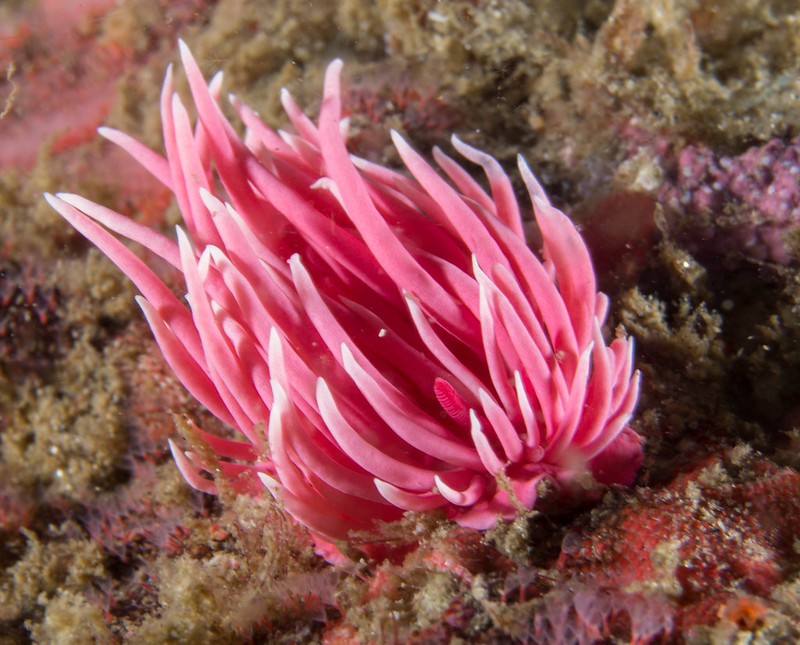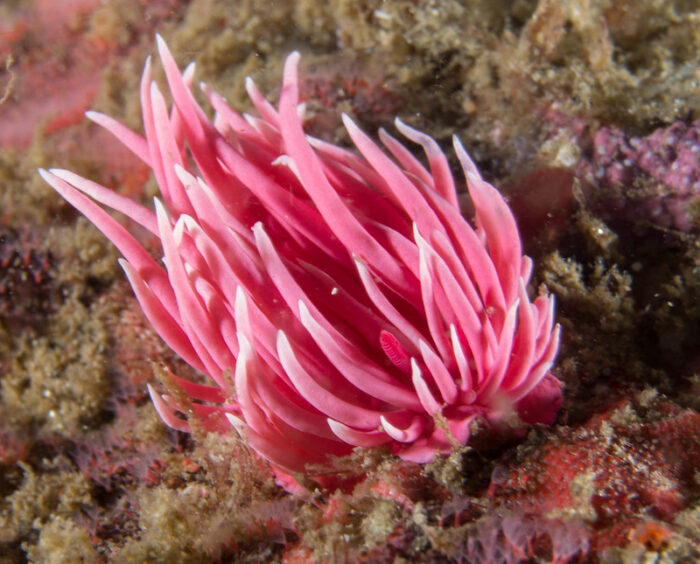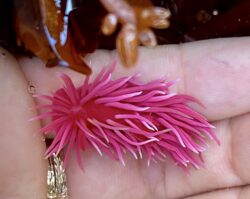
Sea Wonder: Hopkin’s Rose Nudibranch

Photo credit: Lauren J
The Hopkin’s rose nudibranch (Okenia rosacea) is a small, colorful, shell-less sea slug that adds a pop of color to tidepools along North America’s West Coast. This stunning slug is named for its vibrant, rosy-pink coloration, which it gets from its diet of pink encrusting bryozoans, just like flamingos get their flamboyant pink hue from the shrimp they eat. This color isn’t just for show, though – it is a defensive adaptation that signals to predators that they aren’t so tasty.
The Hopkin’s rose nudibranch was first described in 1905 by Frank Mace McFarland, a marine biologist from Stanford University and one of the founders of Hopkins Marine Station in Pacific Grove, California. McFarland, well known for his contributions to malacology (the study of mollusks), originally named the rosy-colored slug ‘Hopkinsia rosacea’ after his friend and patron of the marine lab, Timothy Hopkins.
Description
At first glance the Hopkin’s rose nudibranch might look like a flowery plant, but it is an animal. A marine invertebrate to be exact! The species grows to be about an inch long and is nearly weightless, weighing in at around half a pound. Like other marine gastropods, this nudibranch has a flat, muscular “foot” along the ventral or bottom side of its body that it uses to crawl along the substrate. It also has a pair of feathery rhinophores extending from its head, just above the mouth, that it uses to detect chemical signals from its surroundings in a sense that is similar to what we know to be taste and smell.
The most distinctive feature of the Hopkin’s rose nudibranch are the external feathery gills that adorn its body. These gills are located on the back of the animal, just behind the head. They help the nudibranch to breathe underwater by separating oxygen molecules from the water around it. Fun fact: the word ‘nudibranch’ literally translates to ‘naked gill’!
Diet and Habitat
The Hopkin’s rose nudibranch is a carnivore, which is a factor that distinguishes nudibranchs from other sea slug species. Most nudibranchs are specialized feeders, which means each one feeds on a specific prey species. The Hopkin’s rose nudibranch feeds exclusively on pink encrusting bryozoans. Bryozoans are small, filter-feeding animals that live in colonies. The Hopkin’s rose nudibranch uses its radula, a tongue-like organ covered in sharp teeth, to scrape the bryozoans off the rocks and drawn them into its mouth. The Hopkin’s rose nudibranch has few natural predators; the few that exist are generally other species of nudibranch.
The Hopkin’s rose nudibranch is found in the intertidal zone, where it can be found on rocks, pilings, and other hard surfaces. It is most common in the warmer waters of Southern California, but its range extends from Northern Baja California, Mexico, to the lower Oregon coast. Historically, it was rare to see Hopkin’s rose nudibranchs north of San Francisco, but in recent years they have become more common in southern Oregon. National Marine Sanctuary System, you can find these animals in the tidepools and nearshore waters of Channel Islands, Monterey Bay, and Greater Farallones national marine sanctuaries.
Life History
The Hopkin’s rose nudibranch is a simultaneous hermaphrodite. This means that each individual slug has both male and female reproductive organs and can mate with any sexually mature individual they encounter. When two nudibranchs mate, they exchange both sperm and egg cells. Once fertilized, the eggs are then laid in a clockwise spiral ribbon that the parent attaches to a rock or other hard surface. The eggs that aren’t eaten hatch a few days later into tiny larvae that drift in the water column. After a few weeks, and in the presence of planktonic food, the larvae metamorphose into juveniles and settle on the bottom to grow into adults. Adults live for about a year to 18 months.
Threats and Conservation
The Hopkin’s rose nudibranch is not currently considered to be threatened or endangered. However, it and its fragile rocky shore habitats are vulnerable to the same threats as other marine invertebrates, such as coastal development, runoff pollution, and climate change. This species is ecologically important to its tide pool habitats as they keep other animal populations in balance.
One of the best ways to help protect the Hopkin’s rose nudibranch is to reduce your impact on the marine environment. When you visit tide pools, remember to bring your ocean etiquette. That means we should be careful to tread lightly, touch minimally, to take only pictures and memories with us when we go, and to leave nothing behind but footprints. You can also support organizations like ours that work to understand and protect marine ecosystems.

Photo credit: Sharon Hsu
